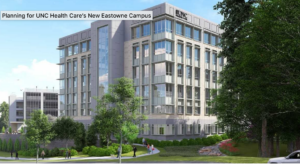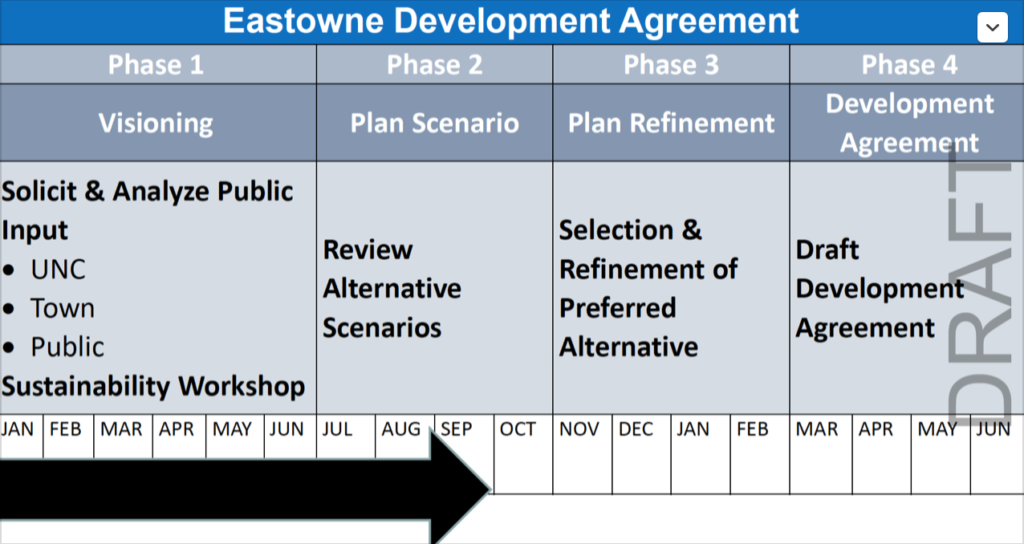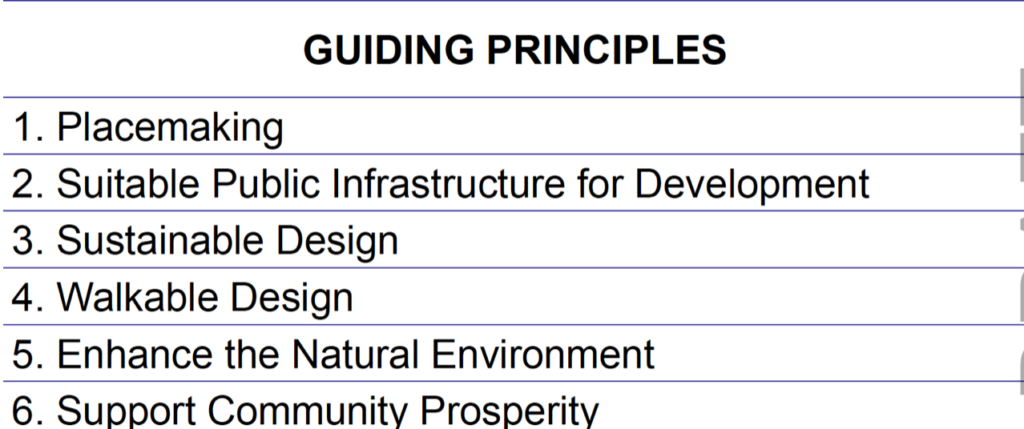Dear Mayor Hemminger and Town Council members,We write to make just two comments on the Eastowne Report that you will comment on tonight.The first comment is that the Eastowne process schedule must be recalibrated. The schedule says the Council Committee and UNC Health are discussing alternate plans but they are doing so without the information they need. It’s very clear that the progress so far has not put you on schedule to hold fully informed discussions about alternative scenarios. (Our September 3 letter below outlines the missing data.)However, the Town’s graphic below shows the Council are ready to move to plan refinement. That is clearly not the case. See slide #1 below.The primary reason is that the Town has insufficient data to meet the excellent principles you have developed. See slide #2 of the principles. Listed here are two areas of missing data:(1) To respect the natural environmenta road system needs to be developed that provides for stormwater retention and the natural areas to be protected;(2) The limits of the capacity of 15-501, a major entranceway to Chapel Hill and this project, have not yet been established.Our second comment is that we are very encouraged by the last joint Eastowne meeting held with UNC Health. We all learned in a traffic presentation that a new Traffic Impact Analysis is underway that will yield estimates for the impact of various scenarios.Please readjust your timeline and expectations to match the data you have received.Thank you for your continued attention to this important task!Julie McClintock for CHALTSlide #1Slide #2_______________________________________________Attached September 3 letter to the Eastowne representatives.September 3, 2019Dear Mayor Pam Hemminger and Council Members Hongbin Gu, Michael Parker, and Rachel Schaevitz:
Tomorrow the Chapel Hill Committee on Eastowne meets again with UNC Health.
We know the Council committee has expressed a strong desire to establish a strong negotiating position before making decisions on the elements of the UNC Health Master Plan for Eastowne. We’ve been disappointed that has not happened. The result has been that UNC Health is putting out plans for your review before you are adequately prepared to make a judgment.
We are writing to request that the Council committee make specific data requests of the Town of Chapel Hill and UNC Health before the process proceeds further. A plan that is not based on good land use data jeopardizes the town’s ability to achieve its goals not only for this site but, also, for the broader area. Chief concerns include water quality, downstream flooding and potential gridlock on a major thoroughfare and gateway to the town.
We commend staff and committee representatives for calling for a formal survey of the Natural Heritage property noted by Ed Harrison and others who have spoken forcefully in favor of the conservation of the Natural Heritage area land. See completed survey. Thank you for making this happen.
Before our representatives commit the Town to any particular density or placement of buildings, a comprehensive process must include the following elements:
- Measureable goals. The Chapel Hill team must set measurable goals for water quality, stormwater management, percentage of tree canopy (but not relying on saplings to grow into mature trees in 30 years) and green space, and amount of additional traffic generated that 15-501 can accommodate. These goals must be set before the joint committee reviews additional concept maps. (The plan, decided at an earlier meeting, to develop measurable outcomes seems to have been abandoned.
- Topo and environmental features. Chapel Hill stormwater staff must develop a detailed topographical map of the tract that includes all environmental features. The map should be jointly discussed and all parties should agree on the features that need to be protected before any buildings are sited and decisions for stream setbacks and infrastructure are decided
- Traffic studies. The Chapel Hill team must understand what Chapel Hill traffic studies show about traffic on 15-501. Questions of density, number of feet of office space mix of uses and number of cars cannot be safely made until the new Traffic Impact Analysis (TIA) that measures total current traffic volumes on 15-501 is complete. The TIA can analyze several scenarios involving different levels of density.
This is the first time a project of this magnitude will be built by UNC Health away from the central hospital complex but within the Town limits. UNC Health has said that they need between 1.8 million to 2.8 million sf of clinics, office space, retail and housing, excluding at least 3 – 4 parking decks.
While the existing office park is peppered with office buildings, the entire site retains a wooded character of gently rolling hills and streams. As noted previously, one 20-acre site containing a valuable old growth oak forest has been left untouched and has been deemed significant and worthy of conservation “by any means feasible” by the North Carolina Natural Heritage Program. An old growth oak forest cannot and will not be replicated.
The Town’s own traffic projections indicate that 15-501 traffic will slow to a crawl for even more hours a day within three years. These projections do not include the additional traffic contributed by this new UNC Health campus. So far, no feasible transit or transportation strategy to handle additional traffic on 15-501 has been discussed. UNC has been insistent so far they need to build 3 – 4 large parking decks, each as big as a football field, to accommodate clients and employees. The Council lacks projections on what those additional cars will mean to traffic on 15-501, a major gateway to Chapel Hill.
For these reasons and many more, we urge the Council to get the data and use it to identify your priorities before reviewing further maps and plans.
Thank you!
Julie McClintock and these additional signers:
David Adams
Charles Berlin
Linda Brown
Linda Carol Davis
Arthur and Debbie Finn
Vivian Foushee
Lindsay Garrison
Laura Goldman
Joan Guilkey
Ed Harrison
Tom Henkel
Bruce Henschel
Charles Humble
Rudy Juliano
Harvey Krasny
Fred Lampe
Susan Morance
John Morris
David Schwartz
Del Snow
Dan Sissors
Tom and Karen Traut
Terry and Robert Vance
Diane Willis



